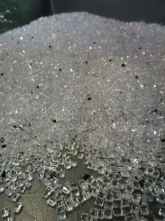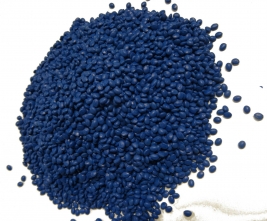Matières
-
Matières Courantes
♦ PEBD
Matière économique et de faible densité (0.93), le PEBD est une matière flexible.
Elle a de nombreuses applications dans les tubes plongeurs ,dans la parfumerie et le médical, est apte au contact alimentaire et dans certains cas conforme à la Pharmacopée. Elle possède une bonne résistance aux chocs et de bonnes propriétés diélectriques ainsi qu’une bonne résistance aux produits chimiques, notamment alcools et solvants.
Elle ne peut cependant pas être utilisée pour des applications en température et est sensible aux UV. Elle est facilement colorable.
♦ PEHD
Matière économique et de faible densité (0.945) c’est une matière rigide ayant un module de flexion 1150 MPa .
Elle est apte au contact alimentaire et, dans certains cas, conforme à la Pharmacopée.
Elle a de très bonnes propriétés de glissement, de résistance aux chocs et de bonnes propriétés diélectriques.
Elle présente également une excellente résistance à de nombreux produits chimiques
Cependant ,elle est sensible au stress-cracking et aux UV.
Elle est facilement colorable.
♦ PP
Matière économique de très faible densité (0.90), c’est une matière rigide de module de flexion 1300 MPa .
Le PP est particulièrement résistant à la flexion (charnières), il a une très bonne résistance à de nombreux agents chimiques. Sa tenue en température est supérieure à celles des Polyéthylènes, mais il est fragile pour des utilisations au froid. Il a une faible perméabilité à l’eau et à la vapeur d’eau. Il possède une très bonne aptitude à la coloration et est souvent utilisé dans le domaine du jouet.
Il existe de nombreuses versions de PP ayant des propriétés de rigidité, et de transparence différentes. PP copolymère améliorant la résistance aux chocs, PP homopolymère pour une meilleure rigidité. Cette rigidité peut encore être améliorée en ajoutant des charges minérales.
♦ PVC
C’est une matière très largement utilisée en extrusion car elle se transforme relativement aisément, est économique et offre de nombreux grades.
Nous transformons des PVC souples de dureté 60 Sh. A jusqu’ à une dureté de 42 Sh.D en versions transparentes et aisément colorables.
Nous transformons également des PVC rigides, transparents ou de coloris naturel ivoire, de grade alimentaire ou non, et également des PVC surchlorés.
La combinaison PVC souple / PVC rigide est souvent utilisé pour la co-extrusion .
En fonction de sa dureté la densité du PVC est comprise entre 1.25 pour les plus souples et 1.45 pour les grades non plastifiés. Le PVC résiste bien à de nombreux acides, aux bases, mais est sensible aux solvants.
Suivant les grades , il peut être utilisé jusqu’à 80 °c en continu.
- Matières techniques
♦ Polyamide 6
Matière rigide , résistant bien à l’usure , aux chocs et ayant un bon coefficient de glissement .Elle peut être utilisée en continu jusqu’à 80 °C. Le Polyamide 6 a une bonne résistance aux carburants. Il absorbe néanmoins l’humidité ambiante et ses caractéristiques mécaniques et dimensionnelles sont alors modifiées.
La matière a une densité de 1.14 . Son module de flexion est de 2600 MPa et après conditionnement, de 700 MPa
♦ Polyamide 66
Les propriétés de cette matière sont assez semblables à celles du PA 6 .Elle a cependant de meilleures caractéristiques mécaniques et peut être utilisée en continu jusqu’à 100 °.
Comme le PA 6, cette matière reprend l’humidité .Sa densité est de 1.14 .
Elle peut être modifiée pour en améliorer la ténacité ou chargée de fibre de verre pour améliorer ses propriétés mécaniques.
Son module à sec est de 2900 MPa et après conditionnement, de 1200 MPa
♦ POM
Matériau rigide avec de très bonnes propriétés de glissement et de résistance à l’usure, il est très utilisé en mécanique.
Contrairement aux Polyamides, il absorbe faiblement l’humidité. Il peut être utilisé en continu jusqu’à 100 °c .
Il résiste très bien aux carburants, aux solvants mais pas aux acides et bases fortes. Il se colle mal. Le POM Homopolymère, possède de meilleures propriétés mécaniques et tenue en température que la version Copolymère qui aura une meilleure résistance aux produits chimiques et à l’hydrolyse. Il n’existe pas de version ignifuge.
Son module de flexion est de 2600 MPa. Sa densité est de 1,42.
♦ PC
La caractéristique principale du Polycarbonate est sa grande résistance aux chocs. C’est un matériau transparent. Il peut être utilisé en continu jusqu’à 120 °c environ.
Il résiste peu aux produits chimiques et à l’hydrolyse. Il possède de bonnes qualités d’isolant électrique.
Son module de flexion est de 2350 MPa. La densité du Polycarbonate est de 1.20 .
♦ ABS
Cette matière s’extrude aisément. Elle peut être utilisée en continu jusqu’à 70 °c environ et résiste bien aux chocs à basse température.
Elle résiste bien à la rayure et présente un bon rendu de couleurs. Elle est cependant sensible à l’exposition extérieure.
Son module de flexion est de 1950 MPa et sa densité est de 1.05
♦ PVDF
Ce polymère fluoré, est une matière rigide, présentant une excellente tenue aux UV ,
à de nombreux produits chimiques, ainsi qu’une grande imperméabilité aux gaz et aux liquides.
Sans contrainte mécanique, sa température d’utilisation en continu peut atteindre 130 °c.
Son module de flexion est de 2100 MPa et sa densité est de 1.78 .
♦ PEI
Cette matière rigide présente une tenue en température élevée jusqu’à 180 ° C, elle est auto-extinguible avec une faible émission de fumées. Sa couleur naturelle, ambre, ne favorise pas la coloration.
Sa densité est de 1.27 et son module de flexion de 3200 MPa.
♦ PEEK
Matière rigide , elle peut être utilisée en continu jusqu’à 260 ° c, avec une grande ténacité, une grande stabilité dimensionnelle, mais une résistance aux chocs limitée.
Le PEEK résiste bien aux solvants , à l’hydrolyse et aux doses élevées de radiations gamma.
De densité 1.3, le PEEK a un module de flexion de 3000 MPa.
- Matières souples et élastomères :
TPU, TPEE, TPV , EVA, SBS, SEBS …
Les propriétés sont très liées à la dureté du grade qui peut aller de 30 Sh. A à 60 Sh. D
En conséquence, il est difficile de pouvoir caractériser l’ensemble d’une famille en quelques lignes.
Un échange avec notre client portant sur les caractéristiques attendues de son produit et des conditions de fonctionnement permettront de définir la matière la plus adéquate.




